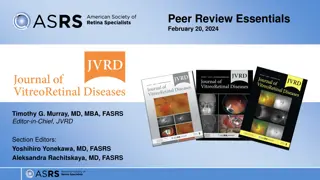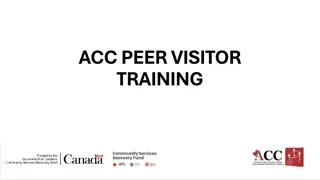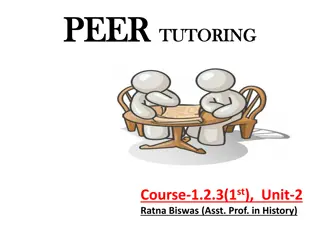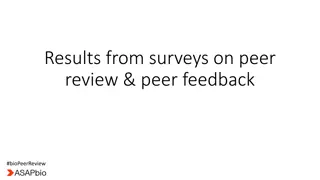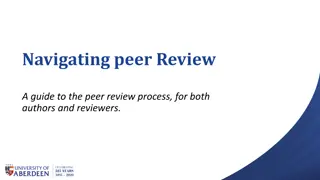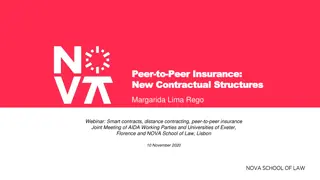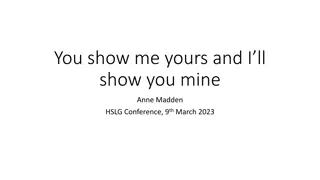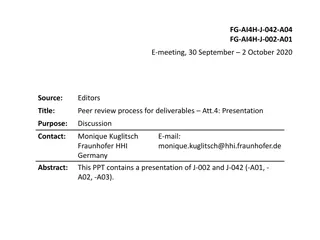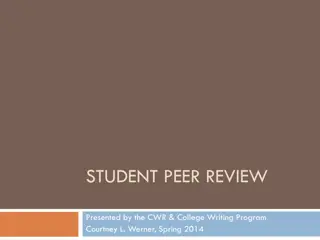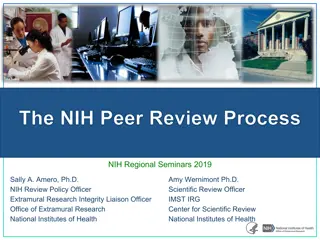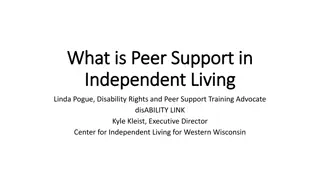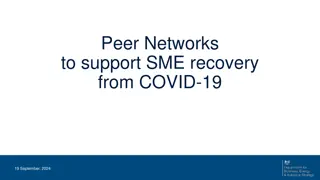Models of peer review
Delve into the world of peer review with insights on various models such as single blind, double blind, and triple blind. Learn about the advantages and disadvantages of each model, how they impact reviewers and authors, and their prevalence across different subject areas. Gain a comprehensive understanding of the peer review process and its significance in scholarly communication.
Uploaded on Feb 23, 2025 | 0 Views
Download Presentation

Please find below an Image/Link to download the presentation.
The content on the website is provided AS IS for your information and personal use only. It may not be sold, licensed, or shared on other websites without obtaining consent from the author.If you encounter any issues during the download, it is possible that the publisher has removed the file from their server.
You are allowed to download the files provided on this website for personal or commercial use, subject to the condition that they are used lawfully. All files are the property of their respective owners.
The content on the website is provided AS IS for your information and personal use only. It may not be sold, licensed, or shared on other websites without obtaining consent from the author.
E N D
Presentation Transcript
Models of peer review An introduction to different types of peer review Presented by Dr. Bahar Mehmani 2019
About the speaker Dr. Bahar Mehmani Reviewer Experience Lead, Elsevier @mehmanib | 2
Contents Section 1.2: Models of peer review a. Different peer review models: definitions and attitudes b. Internal peer review and editorial office vs. external peer review | 3
Different models of peer review Authors Reviewers Anonymized Identified Anonymized Double Blind - Identified Single Blind Open review Editor still knows the identity of Authors. Triple blind is when the identity and affiliation of authors is anonymized for the handling editor. | 4
Single blind peer review The reviewer is anonymous to author while the author s name and affiliation is available to the reviewer. Single blind is the common peer review policy in many subject areas such as physical science Advantages Disadvantages Reviewers can criticize without any influence being exerted on them by authors Does not protect authors from gender, or any other sort of bias | 5
Double blind peer review Both the reviewer and author are kept anonymous from each other Double blind is as more common in social science and is gaining traction in other subject areas Advantages Disadvantages Reviewers can criticize without any influence being exerted on them by authors It is extremely difficult in practical terms to fully anonymize authors and reviewers (self-citation, subject, or writing/presentation style) Reduces the possibility of bias | 6
Triple blind peer review Authors identity and affiliation is anonymized to reviewers, and editors during the peer review process Not a well-known process in many subject areas Advantages Disadvantages Reviewers can criticize without any influence being exerted on them by authors Lack of systematic studies of its efficiency Reduces the possibility of bias from editors It is extremely difficult in practical terms to fully anonymize authors and reviewers (self-citation, subject, or writing/presentation style) | 7
Open peer review Name of the reviewer is disclosed to authors or upon publication to readers Content of peer review reports are available to readers either signed or anonymously Still not common in many subject areas Advantages Disadvantages Increases transparency and credibility It is a recent concept without much in the way of supporting data or validation Provides recognition to reviewers Many definitions of open peer review (see the second article below) cause confusion Useful read: The effect of publishing peer review reports on referee behaviour What is open peer review? | 8
Attitudes towards different types of peer review REVIEW ON A JOURNAL SUBMIT TO A JOURNAL % More likely 2011 2013 2015 2011 91% 2013 2015 91% 86% 86% 85% 85% Single blind 82% 82% 84% 82% 82% 81% Double blind Open peer review (Reviewer known to author only) 53% 52% 48% 44% 43% 42% Open peer review (Reviewer name next to article) 52% 45% 51% 45% 38% 42% Open peer review (Reviewer s name and report posted) 29% 36% 33% 31% 26% 29% Post-publication assessment (Peer reviewed before publication) 53% 53% 53% 45% 52% 45% Post-publication assessment (No peer review before publication) 23% 17% 22% 21% 14% 21% | 9 Link to the survey Base: 2015 all respondents (n= 2,004); 2013 all respondents (n=3,008), 2011 all respondents (n=2,700)
Internal peer review Handling editor evaluates submissions and determines whether they enter into the external review process or are rejected Peer review is conducted by the editorial staff of the journal One or more of the journal editors serves as referee Decision is made by editor once all referee reports are discussed Useful read: The effects of an editor serving as one of the reviewers during the peer-review process | 10
External peer review Handling editor does not review the manuscript but knows the community and subject areas very well Handling editor invites experts in the field to peer review the manuscript Handling editor makes a decision based on submitted review reports | 11
Thank you. Ask your questions on: Researcher Academy Mendeley group Follow us on Twitter









